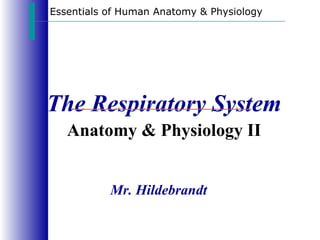Respiratory System Notes
•
201 gefällt mir•130,678 views
This slideshow is intended for students in Mr. Hildebrandt's anatomy & physiology classes.
Melden
Teilen
Melden
Teilen

Empfohlen
Empfohlen
Weitere ähnliche Inhalte
Was ist angesagt?
Was ist angesagt? (20)
Ähnlich wie Respiratory System Notes
Ähnlich wie Respiratory System Notes (20)
anatomyandphysiologyoftherespiratorysystem-180129061553.pdf

anatomyandphysiologyoftherespiratorysystem-180129061553.pdf
respiratory system and related organs anatomy physiology

respiratory system and related organs anatomy physiology
Mehr von Shakopee Public Schools
Mehr von Shakopee Public Schools (20)
Kürzlich hochgeladen
God is a creative God Gen 1:1. All that He created was “good”, could also be translated “beautiful”. God created man in His own image Gen 1:27. Maths helps us discover the beauty that God has created in His world and, in turn, create beautiful designs to serve and enrich the lives of others.
Explore beautiful and ugly buildings. Mathematics helps us create beautiful d...

Explore beautiful and ugly buildings. Mathematics helps us create beautiful d...christianmathematics
Kürzlich hochgeladen (20)
Python Notes for mca i year students osmania university.docx

Python Notes for mca i year students osmania university.docx
Asian American Pacific Islander Month DDSD 2024.pptx

Asian American Pacific Islander Month DDSD 2024.pptx
Unit-IV; Professional Sales Representative (PSR).pptx

Unit-IV; Professional Sales Representative (PSR).pptx
Explore beautiful and ugly buildings. Mathematics helps us create beautiful d...

Explore beautiful and ugly buildings. Mathematics helps us create beautiful d...
This PowerPoint helps students to consider the concept of infinity.

This PowerPoint helps students to consider the concept of infinity.
UGC NET Paper 1 Mathematical Reasoning & Aptitude.pdf

UGC NET Paper 1 Mathematical Reasoning & Aptitude.pdf
ICT Role in 21st Century Education & its Challenges.pptx

ICT Role in 21st Century Education & its Challenges.pptx
Respiratory System Notes
- 1. Essentials of Human Anatomy & Physiology The Respiratory System Anatomy & Physiology II Mr. Hildebrandt
- 2. Respiratory System Functions • Gas exchange between the blood and external environment • Exchange of Oxygen & Carbon Dioxide takes place within the lungs in the alveoli • Purify, warm, and humidify the incoming air • Produce sound for communication
- 3. Nonrespiratory Functions • Actions can be caused by reflexes or voluntary actions • Examples: • Cough – clears lungs of debris • Sneeze – clears upper respiratory tract • Yawn – deep inspiration triggered by ??? • Hiccup – phrenic nerve is irratated which leads to rhythmic spasms.
- 4. Organs of the Respiratory system • Nose • Pharynx • Larynx • Trachea • Bronchi • Lungs – alveoli Figure 13.1
- 5. The Nose • The only externally visible part of the respiratory system • Air enters the nose through the external nares (nostrils) • The interior of the nose consists of a nasal cavity divided by a nasal septum
- 7. Nasal Cavity • Lateral walls have projections called conchae • Nasal cavity is separated from the oral cavity by the hard & soft palates • Olfactory receptors are located in the mucosa on the superior surface • Cavity is lined with respiratory mucosa • Moistens air • Traps incoming foreign particles
- 8. Pharynx (Throat) • Muscular passage from nasal cavity to larynx • Three regions of the pharynx: • Nasopharynx – superior region behind nasal cavity • Oropharynx – middle region behind mouth • Laryngopharynx – inferior region attached to larynx • Oropharynx & laryngopharynx are the passageways for air & food
- 9. Larynx • Vocal cords (vocal folds) • Glottis – opening between vocal cords • Thyroid cartilage • Largest hyaline cartilage • “Adam’s apple” • Epiglottis • Superior opening of the larynx • Routes food to the larynx and air toward the trachea
- 10. Trachea (Windpipe) • Connects larynx with bronchi • Lined with ciliated mucosa • Beat continuously in the opposite direction of incoming air • Expel mucus loaded with dust and other debris away from lungs • Walls are reinforced with C- shaped hyaline cartilage
- 11. Primary Bronchi • Formed by division of the trachea • Enters the lung at the hilus (medial depression) • Right bronchus is wider, shorter, and straighter than the left • Bronchi subdivide into smaller and smaller branches
- 12. Lungs • Site of gas exchange • Occupy most of the thoracic cavity • Apex is near the clavicle (superior portion) • Base rests on the diaphragm (inferior portion) • Each lung is divided into lobes • Left lung – two lobes • Right lung – three lobes
- 13. Lungs
- 14. Bronchioles • Smallest branches of the bronchi • Terminal bronchioles end in alveoli • All but the smallest branches have reinforcing cartilage
- 15. Alveoli • Gas exchange takes place within the alveoli in the respiratory membrane • Tiny blood capillaries surround alveoli and allow for simple diffusion of O2 & CO2
- 16. Coverings of the Lungs • Pulmonary Pleura covers the lung surface • Pleural fluid fills the area between layers • Macrophages add protection • Surfactant coats gas-exposed alveolar surfaces
- 17. Mechanics of Breathing Inspiration • Diaphragm and intercostal muscles contract • The size of the thoracic cavity increases • External air is pulled into the lungs due to an increase increased volume Exhalation • As muscles relax, air is pushed out of the lungs • Forced expiration can occur mostly by contracting internal intercostal muscles to depress the rib cage
- 18. Respiratory Volumes and Capacities • Tidal Volume - Normal breath; moves about 500 ml of air with each breath • Vital Capacity – Maximum quantity of air in one breath; usually 4500-5500 mL • Dead Space Volume • Air that remains in conducting zone and never reaches alveoli • About 150 ml • Total Lung Capacity – Maximum amount lungs can hold; usually 4650-6400 mL
